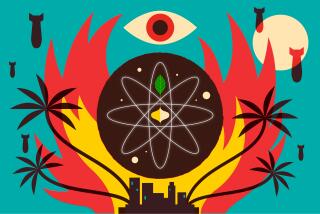‘Age of Edison’ sheds light on how America got wired
- Share via
Today, electricity is so inextricably woven into the fabric of our lives that we don’t even think about it: We flick a switch and a light comes on — until, as millions in the Northeast discovered during Hurricane Sandy, it doesn’t, and you learn that it can take days or even weeks to restore the complex electric grid inaugurated more than a hundred years ago.
One of the many pleasures of “Age of Edison,” Ernest Freeberg’s engaging history of the spread of electricity throughout the United States, is that he captures the excitement and wonder of those early days, when “a machine that could create enough cheap and powerful light to hold the night at bay” promised “liberation from one of the primordial limits imposed by nature on the human will.”
Freeberg sketches electric light’s transformative effect on everything from factory work and home life to shopping and entertainment, painting vivid pictures of this brave new world in evocative prose. (His previous book, “Democracy’s Prisoner,” was a finalist for the Los Angeles Times Book Prize.) We can practically see the brightly lighted displays of merchandise that lured consumers into electrified department stores. Amusement parks glitter in the mind’s eye as Freeberg describes their metamorphosis via electricity into illuminated pleasure grounds, packed with paying customers long after nightfall.
Underpinning these atmospheric particulars is the larger story of the volatile, often contentious interaction between private enterprise and public policy that has shaped the American economy since the days of the Erie Canal.
Private enterprise led the way. Others had created a working light bulb before Thomas Edison unveiled his incandescent light bulb in 1879, Freeberg remarks, but “Edison invented a new style of invention, a coordinated program of scientific research and product development.”
It was the prospect of a salable product that brought investors flocking to Edison, and the United States led the world in the commercial development of electric lighting systems. The conceptual scientific breakthroughs mostly occurred in Europe, but Edison and other American inventors applied them to practical technologies, which American entrepreneurs aggressively marketed and the American public embraced with a speed that Europeans, writes Freeberg, “found both fascinating and reckless.”
It was reckless, as many municipalities discovered after a decade of anarchic expansion. More than 600 companies touting a dozen rival lighting systems competed to electrify America’s cities and towns, paying little attention to safety in their rush to sell. A fire caused by shoddy wiring destroyed much of Boston’s business district in 1889. That same year, a telegraph lineman was electrocuted by an overhead wire in Manhattan; it took authorities days to determine which companies owned the various wires on the pole.
Such incidents sparked a backlash against electricity, and urban reformers pushed for municipal ownership of utilities. The electrical industry reluctantly concluded that “reasonable” regulation was preferable to this “hazardous step toward socialism.” Cities like Boston did enact laws, but the first national safety standards were imposed by private insurance companies, some of which faced bankruptcy because of payouts for the growing number of catastrophic electrical fires. The United States was willing to let the marketplace determine matters that Europeans considered the province of government.
The quest for profit certainly inspired the rapid adoption of electricity by American businesses. Electric light enabled factory owners to keep expensive machinery running on a 24-hour schedule and to institute longer working hours that prompted union activists to predict electricity would bring only further misery to the laboring masses.
Yet others welcomed electric light as liberation from the hot, smelly workplaces lighted by gas. Like many other industries formed by Gilded Age capitalism, electrical power was simultaneously a source of enormous individual wealth, a contributor to the growing income gap between America’s rich and poor, and the provider of modern conveniences to a broad spectrum of the population.
“The benefits of electrical power seemed widely democratized,” Freeberg comments, pointing out that all citizens benefited from lighted city streets and town centers. The economies of scale achieved as the chaotic industry consolidated into two major corporations, General Electric and Westinghouse, made domestic electricity increasingly affordable for middle-class consumers and urban workers. By 1930, 70% of all U.S. households were wired. The dynamic free market, its worst excesses occasionally checked in the public interest, had electrified the nation.
The grid’s only gap was in rural America. “Private utilities had little incentive to make the massive investment needed to reach these potential customers,” Freeberg explains. Not until the New Deal, when the federal government supplied funds to build generating stations and run power lines, did the countryside finally gain access to electricity. Political action was required to completely fulfill the promises first made half a century earlier by freebooting electrical salesmen.
Freeberg makes no sweeping value judgments in his richly detailed chronicle of electric light’s revolutionary influence on every aspect of American life. It was a collective achievement, he demonstrates; Edison and fellow inventors created the technology, but they could not foresee the myriad uses made of it, from manufacturers hawking their wares with electric signs to doctors literally shining a light into patients to better diagnose their ailments. Electric illumination prevented collisions in crowded shipping lanes and lowered crime rates in once-dark slum neighborhoods. Freeberg’s thoughtful and thought-provoking book quietly suggests that, to properly distribute and control such a powerful force, commercial initiative and a sense of civic responsibility were equally essential.
Smith is the author of “Real Life Drama: The Group Theatre and America, 1931-1940,” which will be reissued in May.
The Age of Edison
Electric Light and the Invention of Modern America
Ernest Freeberg
Penguin Press: 368 pp., $27.95
More to Read
Sign up for our Book Club newsletter
Get the latest news, events and more from the Los Angeles Times Book Club, and help us get L.A. reading and talking.
You may occasionally receive promotional content from the Los Angeles Times.









